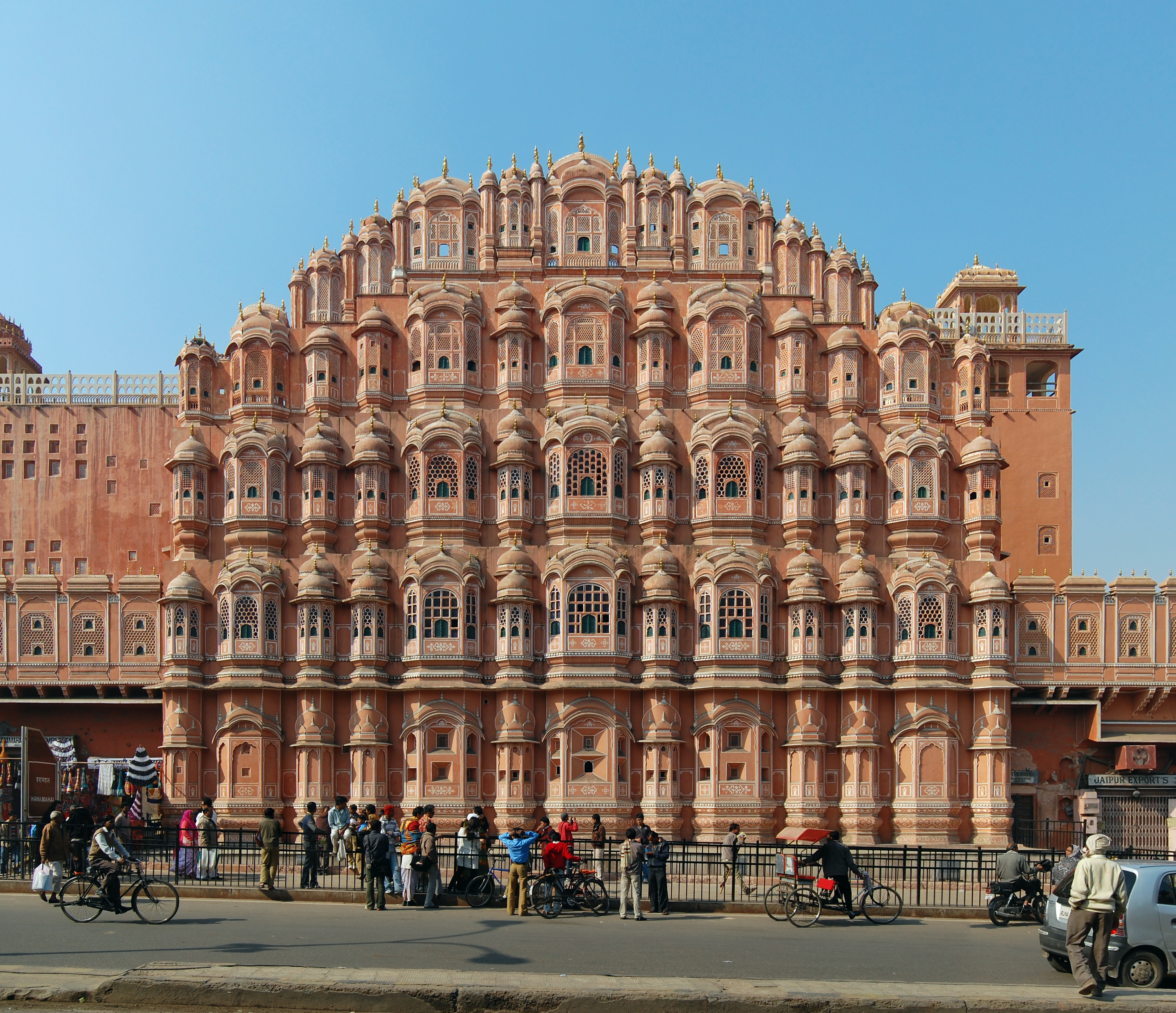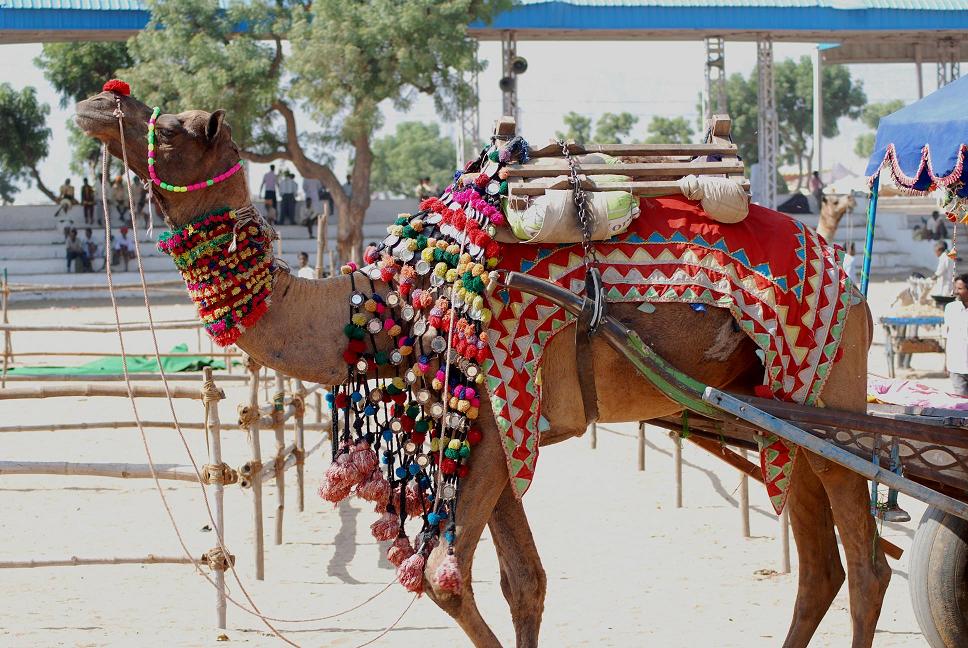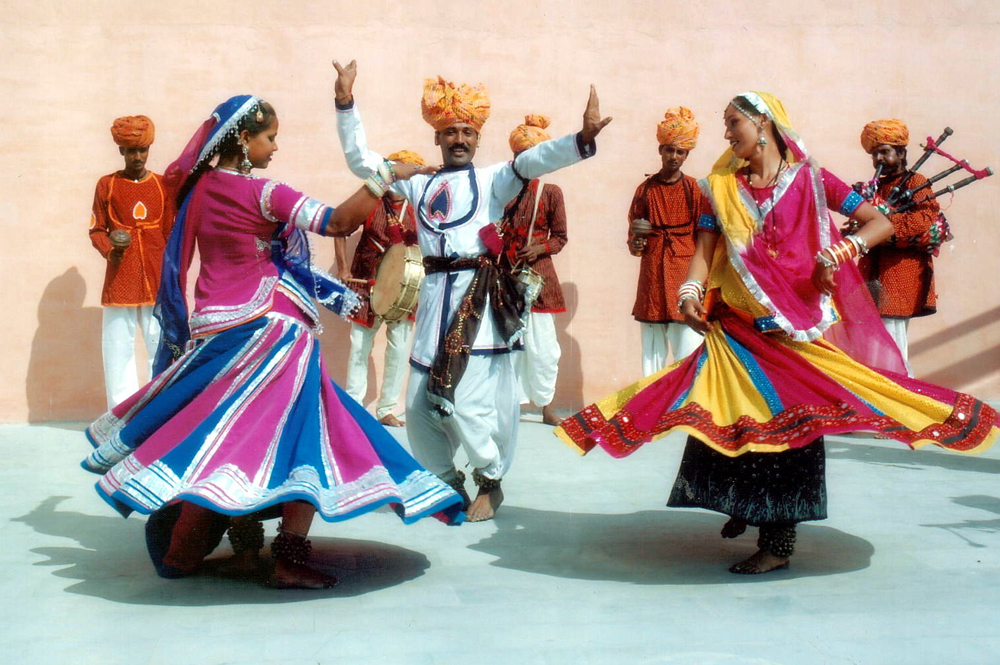Rajasthan
-Padharo Mahare Desh
Rajasthan is located in the north-western part of the Indian subcontinent. It is known as the “Land of Kings” and is the largest Indian state by area.
 It is bounded to the north and northeast by the states of Punjab and Haryana, to the east and southeast by the states of Madhya Pradesh and Uttar Pradesh.
It is bounded to the north and northeast by the states of Punjab and Haryana, to the east and southeast by the states of Madhya Pradesh and Uttar Pradesh.
To the southwest by the state of Gujarat, and to the west and northwest by the provinces of Sindh and Punjab in Pakistan.
The Thar Desert and the Aravalli Range, runs through the state from southwest to northeast, almost from one end to the other.
About three-fifths of Rajasthan lies northwest of the Aravallis and Mount Abu lies at the southwestern end of the range.
The northwestern portion of Rajasthan is generally dry and sandy and most of this region is covered by the Thar Desert. Temperatures can sometimes exceed 54 °C in the summer and drop below freezing point in the winter.
The Aravalli Range and the east and southeast lands of the range are more fertile and better watered. The hilly Vagad region lies in southernmost Rajasthan, is the wettest region in Rajasthan, and the most heavily forested. Eastern and southeastern parts of Rajasthan are drained by the Banas and Chambal rivers.
History of Rajasthan:
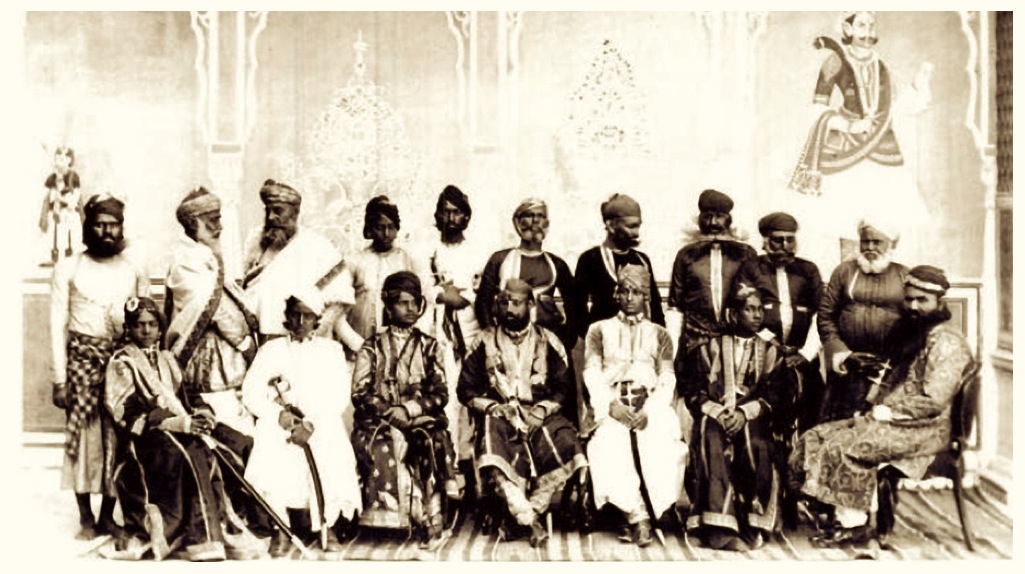 Archaeological evidence indicates that Rajasthan was a part of the Vedic Civilisation and Indus Valley Civilization. Kalibangan was a provincial capital of the Indus Valley Civilization and Balathal site in Udaipur district shows a settlement belonging to the Harappan civilisation.
Archaeological evidence indicates that Rajasthan was a part of the Vedic Civilisation and Indus Valley Civilization. Kalibangan was a provincial capital of the Indus Valley Civilization and Balathal site in Udaipur district shows a settlement belonging to the Harappan civilisation.
The former state of Jaipur in Rajasthan and the whole of Alwar with portions of Bharatpur corresponded to the Matsya Kingdom of the Vedic civilisation of India.
The Saka rulers, successors to the Indo-Scythians, invaded the area of Ujjain and established the Saka era in the 2nd to the 4th century CE.
Prithviraj Chauhan defeated Muhammad Ghori in the First Battle of Tarain in 1191 but In 1192 CE, Muhammad Ghori defeated Prithviraj at the Second Battle of Tarain, and a part of Rajasthan came under Muslim rulers.
The Rana’s of Mewar resisted the outside rule. Rana Hammir Singh defeated the Tughlaq dynasty. Rana Kumbha defeated the Sultans of Gujrat and Malwa and made Mewar the most powerful Rajput Kingdom in India.
Rana Sanga united different Rajput clans and fought against the foreign powers in India. He defeated the Afghan Lodi Empire of Delhi and crushed the Turkic Sultanates of Malwa and Gujarat.
He was defeated by the first Mughal Emperor Babur at Khanua.
Hem Chandra Vikramaditya, defeated Akbar’s forces twice at Agra and Delhi in 1556 at Battle of Delhi gaining the throne of Delhi and establishing the “Hindu Raj ” in North India.
He was killed in the battlefield at the Second Battle of Panipat fighting against Mughals.
During Akbar’s reign, most of the Rajput kings accepted Mughal suzerainty and by the end of the 16th Century, Akbar was able to achieve many kingdoms through diplomacy and military actions. Maharana Pratap fought the Mughals till his death and liberated most of Mewar.
He became the most celebrated warrior of Rajasthan and was famous all over India for his noble actions and warfare. During Aurangzeb’s rule, Rana Raj Singh I and Veer Durgadas Rathore took advantage of the Aravalli hills and caused heavy damage on the Mughal armies that were trying to occupy Rajasthan.
After Aurangzeb’s death Bahadur Shah I tried to control Rajasthan like his ancestors but his plan could not succeed when the three Rajput Rajas of Amber, Udaipur and Jodhpur joined together to attack the Mughals.
They first recovered Amer by a night attack and then killed many other Mughal officers and Bahadur Shah I was forced to patch up a truce with them.
 With the decline of the Mughal Empire in the late 18th century, Rajputana came under the influence of the Marathas, which was then finally replaced by the British Empire in 1818.
With the decline of the Mughal Empire in the late 18th century, Rajputana came under the influence of the Marathas, which was then finally replaced by the British Empire in 1818.
In the 19th century, the Rajput kingdoms had been drained financially and in manpower after continuous wars and to save their kingdoms the Rajput kings concluded treaties with the British.
Modern Rajasthan includes most of Rajputana, which comprises the 19 princely states, the British district of Ajmer-Merwara, Jaisalmer, Marwar (Jodhpur), Bikaner, Mewar (Chittorgarh), Alwar and Dhundhar (Jaipur) were some of the main Rajput princely states.
Tonk was a princely state under Pathans, Bharatpur and Dholpur were Jat princely states.
Popular languages of Rajasthan:
The people of Rajasthan converse in many different languages. Hindi is the official and also the most widely spoken language in the state.
Rajasthani is one of the main spoken languages in the state that includes Marwari, Merwari, Shekhawati, etc. Some people also speak Bhili, Punjabi, and Urdu.
Capital of Rajasthan:
Jaipur is the capital of Rajasthan and is also the largest city in Rajasthan.
Chief Minister (CM) of Rajasthan:
Ashok Gehlot is the chief minister of Rajasthan at present.
Governor of Rajasthan:
Kalraj Mishra is the Governor of Rajasthan.
Rajasthan High Court:
The Rajasthan High Court is located in Jaipur.
Map of Rajasthan:
Rajasthan Tourism:
 Rajasthan is the land of Maharajas, lakes, grace, emotions, adventure, vibrancy, full of cheerfulness and unique charm. Even in this era where development has taken over, the state remains truthful to its roots and customs.
Rajasthan is the land of Maharajas, lakes, grace, emotions, adventure, vibrancy, full of cheerfulness and unique charm. Even in this era where development has taken over, the state remains truthful to its roots and customs.
Tourism in Rajasthan has increased in recent years as it attracts people from all over the world.
“Padharo Mhare Des”, Welcome to Our Land is the slogan of Rajasthan tourism.
Whether you are a history enthusiast, leisure holiday seeker, a newly-wed couple, thrill-seeker or a culture devotee, Rajasthan promises a fascinating experience for everyone.
Rajasthan is part of the ‘Golden Triangle’ for the tourists visiting places in India.
Best 50 Places To Visit In Rajasthan:
1. Mount Abu – Hill Station Of Rajasthan
It is the only hill station of Rajasthan, embraced by lush green hills of the Aravalli range.
Lakes, waterfalls, British style bungalows, royal holiday lodges are the main attraction here.
2. Rajsamand – The Marble Land Of Rajasthan
It quite well known for marble production and is the largest marble producing district in the country. Rajsamand houses beautiful lakes, palaces, and also a national park.
The most famous spots in the district are the Kumbhalgarh Fort, Haldighati, Dwarikadheesh, Charbhuja and a number of Shiv temples.
3. Jaisalmer – The Golden City
The city of Jaisalmer acts as the guard to western Rajasthan and India’s frontier and is located close to the Pakistan border and in close proximity to the Thar Desert.
The city’s most prominent landmark is the Jaisalmer Fort, also called Sonar Quila (Golden Fort). It is not just a tourist attraction. It houses shops, hotels and ancient Havelis where generations continue to live.
4. Jaipur – The Pink City
The capital city holds the distinction of being the first planned city of India. The city was painted pink as a symbol of hospitality.
5. Jodhpur – The Blue City
It is the second-largest city in Rajasthan. The houses, temples, Havelis are built in vivid shades of blue.
6. Udaipur – City Of Lakes and Palaces
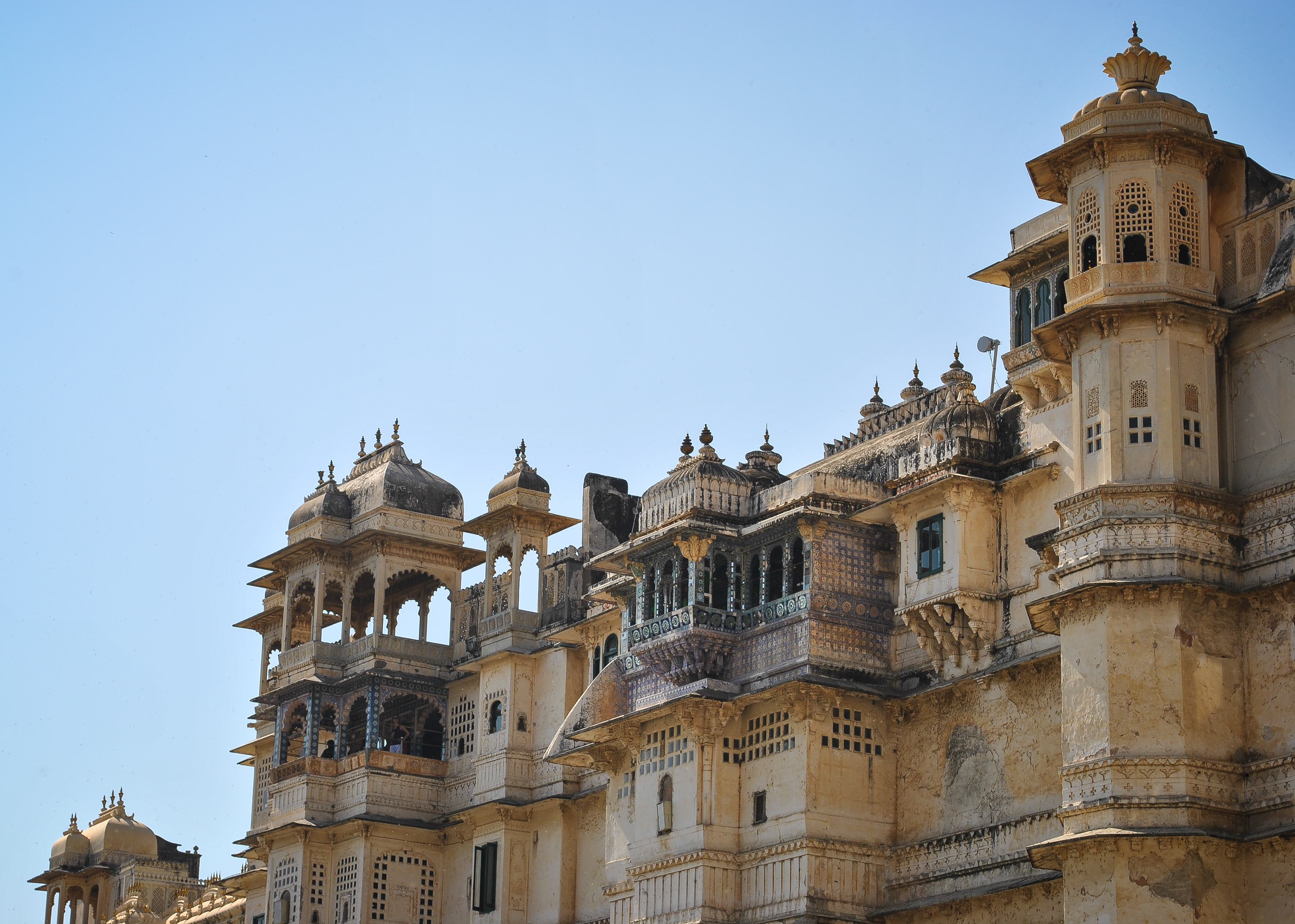 The city is known for the famous Lake Palace, the beautiful City Palace and Monsoon Palace, Lake Pichola, Jaisamand Lake and Fateh-Sagar lake and many others.
The city is known for the famous Lake Palace, the beautiful City Palace and Monsoon Palace, Lake Pichola, Jaisamand Lake and Fateh-Sagar lake and many others.
7. Alwar – The Gateway City Of Rajasthan
It is one of the oldest cities in Rajasthan. It is also known as Matsya Desh, where the Pandavas, of the Mahabharata, spent the last years of their 13-year exile.
It is where the journey of the Fairy Queen ends, the oldest working engine in the world and one of India’s national treasures.
8. Ajmer
This bustling city is a perfect representation of the diversity of Indian culture. The most famous tourist places to visit in Ajmer is the Ajmer Sharif Dargah, the shrine of Khwaja Moin-ud-din Chishti.
9. Bikaner – The Camel Country
The unique aspect of Bikaner is the sand dunes that are scattered throughout the district. The city has some of the world’s best riding camels and is also home to one of the world’s largest camel research and breeding farms.
10. Chittorgarh – The Land of Finest Fort
It is known for the stories of Rajputana bravery, pride and passion. Chittorgarh is named after the Chittorgarh Fort, which is one of the important forts in Indian History.
11. Pushkar – The Town Of Fairs And Festivities
It is one of the oldest cities in India and is home to the only temple dedicated to Lord Brahma in the whole world. It also holds the famous Pushkar Fair every year.
12. Bharatpur – The Eastern Gateway Of Rajasthan
There are numerous palaces, forts and gardens and is home to one of the world’s best-known bird watching destinations, Keoladeo National Park (KNP).
13. Bundi
It is believed that impressed by this place, Rudyard Kipling wrote a part of his famous novel ‘Kim’ in Bundi. It is a magnificent town with palaces, forts and lakes and has its own fairy tale charm.
14. Banswara – City Of Hundred Islands
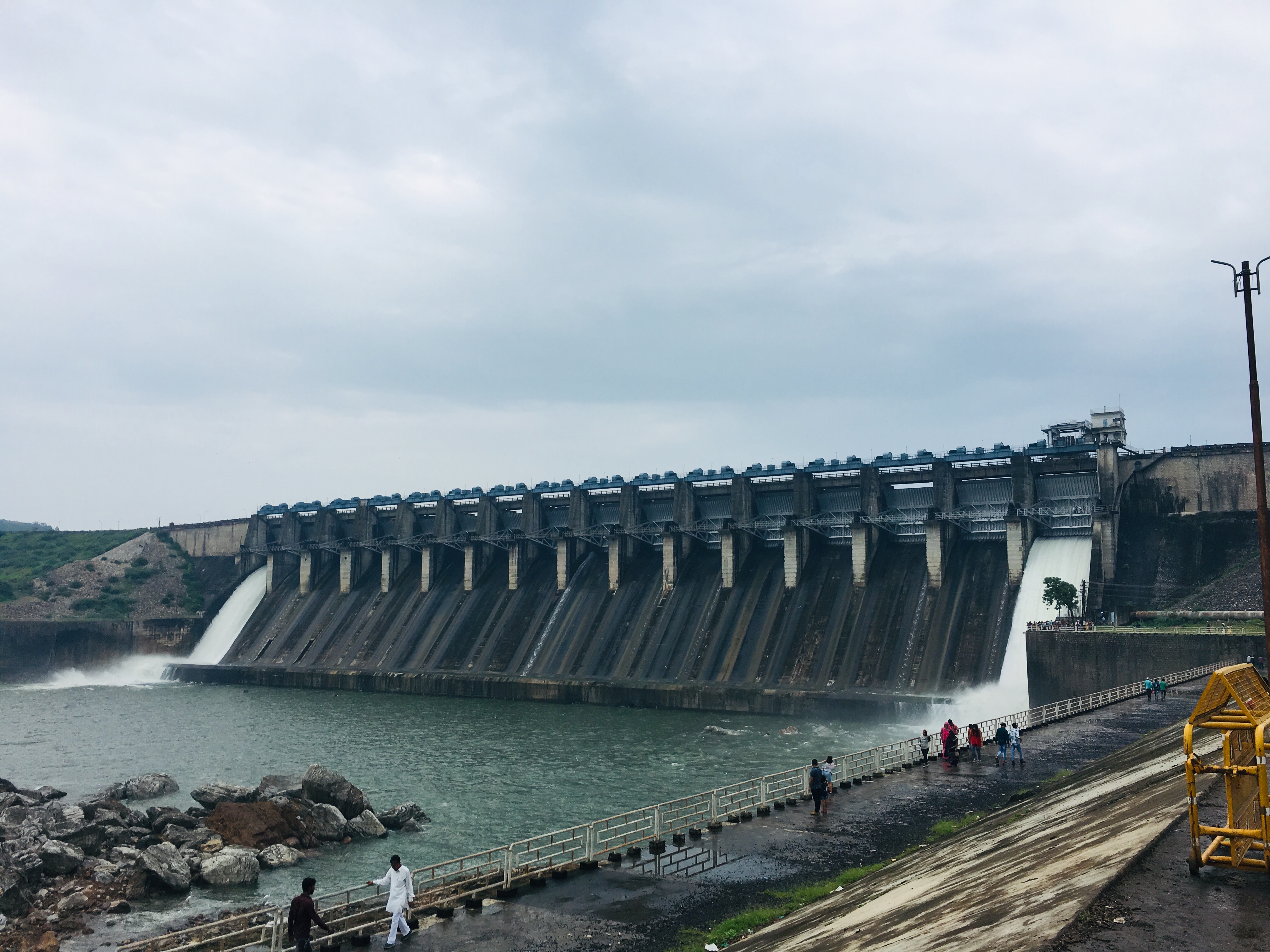 This place has an abundance of islets within the Mahi River. Because of the bamboo trees that grew here, it is also known as the Bamboo Country.
This place has an abundance of islets within the Mahi River. Because of the bamboo trees that grew here, it is also known as the Bamboo Country.
You can witness and explore the scenic beauty of Mother Nature and discover many untold and unheard stories of history.
15. Dungarpur
Today it serves as one of the most attractive tourist destinations in Rajasthan with attractions like historical monuments, enchanting lakes, archaeological museums, religious sites and much more.
16. Jhalawar – The Historical City
Initially called Brijnagar was once a favourite hunting ground of the royal families. It was later renamed as Jhalawar after its founder Rajput Jhala Zalim Singh.
It is one of the least explored destinations but is known for its historical landmarks, glorious forts, stunning palaces and vibrant flora and fauna.
17. Kota – The Land Of The Chambal
Situated on the banks of the Chambal river, it is the third-largest city in Rajasthan and is one of the popular tourist destinations.
The city of Kota is famous for beautiful palaces, temples, distinctive style of paintings, museums, gold jewellery, Doria sarees, silk sarees and the famous Kota stone.
18. Experience Luxury On Wheels
The best way to experience Rajasthan is on one of the worlds most exciting train journeys, The Palace On Wheels.
19. Albert Hall Museum
It is the oldest museum in Rajasthan and also one of the longest functioning museums in the country.
The museum has a collection of a wide range of wood crafts, metal objects, carpets, stone and metal sculptures, arms and weapons, natural stones and ivory goods, miniatures from Bundi, Kota, Kishangarh, Udaipur and Jaipur schools of art, ancient paintings, enchanting crystal works, delicate artefacts, and much more.
20. Garadia Mahadev Temple – Magnificent Temple in Kota
This place is all about peace, blessings, nature’s splendour and privacy. This spot has become quite popular as a picnic destination.
21. Birla Mandir – Modern Marble Marvel
The Lakshmi-Narayan temple in Jaipur Rajasthan is built entirely on white marble. The temple is a marvellous display of carving and sculptures and the images of Lakshmi and Narayan are carved from one piece of marble.
The top of the temple has three domes representing three different religions followed in India.
22. Soniji Ki Nasiyan – Ajmer Jain Temple
This temple is dedicated to Rishabh or Adinath and is an architectural marvel. The entrance is made up of red stone and marble staircase inside is engraved with images of the holy Tirthankars.
Its main chamber, Swarna Nagari has several gold-plated wooden figures within its walls. This temple is counted among the richest temples in India.
23. Rani Sati Mandir
A well-known temple situated in Jhunjhuna district in Rajasthan has a history of more than 400 years and indicates feminine bravery and spirit.
24. Neemrana Fort
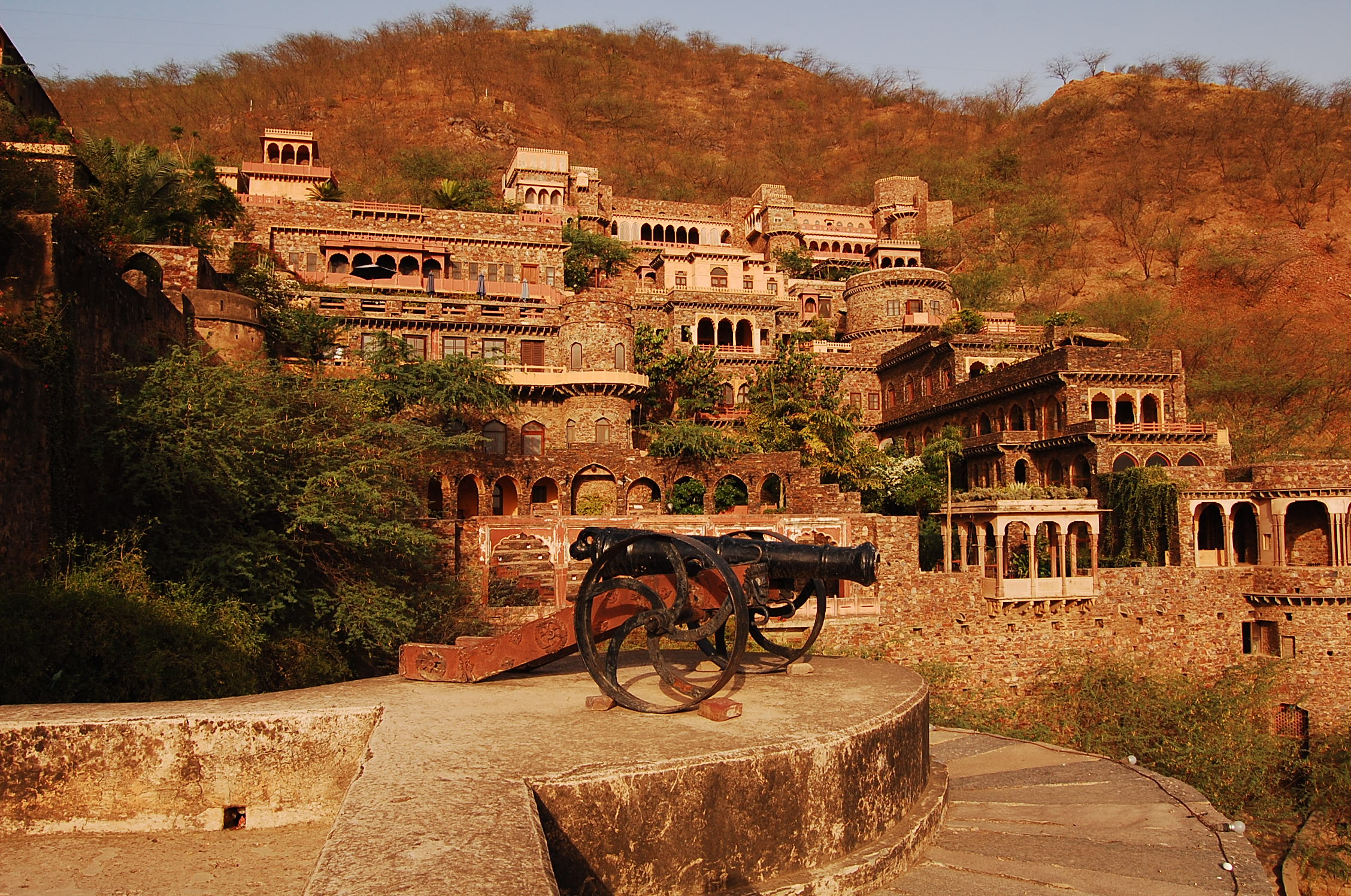 Located in Alwar, this fort is one of the most popular and oldest forts in Rajasthan. This fort is converted into a heritage resort and is a fine example of traditional Rajasthani architecture as well as modern and styled interiors.
Located in Alwar, this fort is one of the most popular and oldest forts in Rajasthan. This fort is converted into a heritage resort and is a fine example of traditional Rajasthani architecture as well as modern and styled interiors.
It offers splendid views of the fort as well as the surrounding ranges.
With two pools around the palace, beautiful rooms, and hanging gardens, among many other features, where people can stay busy while exploring the charm of the palace, enjoying great food, or just relaxing.
25. Ranthambore Fort
It was built by the Chauhan rulers in the 10th century and is characterised by temples, tanks, massive gates and huge walls.
This medieval architectural marvel includes many attractions like Toran Dwar, Mahadeo Chhatri, The Lord Ganesha temple and Sametonki Haveli within its premises.
26. Kuchaman Fort
Located at a height of 300 metres atop a cliff, this fort in Nagaur district of Rajasthan is the biggest attraction in the city of Kuchaman.
This fort constructed by the Rathore ruler Thakur Zalim Singh has ten big gates and is surrounded by 32 bastions. This fort has now been transformed into a luxurious heritage hotel for tourists.
27. Junagarh Fort
Built by Raja Rai Singh, this glorious fortress was constructed in the plains and was initially called ‘Chintamani’.
The fort complex has some magnificent palaces constructed in red sandstone and marble, attractive attractions like courtyards, balconies, kiosks and many other.
28. Mehrangarh Fort
One of the largest forts in India, this magnificent and sturdy fortress Rising perpendicular and impregnable from a hill is 125 metres above Jodhpur’s skyline.
This fort can be accessed through an array of seven gates. This historic fort is known for its latticed and decorated windows, carved panels, decorated walls of Moti Mahal, Phool Mahal and Sheesh Mahal.
29. Amber Palace – Beautiful Melange of Architecture
This huge Amer Palace Fort built on a small hill is the most stunning and artistic architecture in Rajasthan. The magnificent Amer Fort is a palace complex, built with pale yellow and pink sandstone, and white marble.
You can enter the fort through Suraj Pol or Chand Pol.
The fort is divided into four main sections that have their own courtyards and Diwan-e-Khas, Diwan-e-Aam, Sheesh Mahal, Jaleb Chowk, Sukh Niwas and a temple dedicated to Sila Devi are the major attractions of Amber Palace.
30. Desert Camping in Rajasthan
Spend a night in the Thar Desert and stay secluded from the rest of the world to experience the silence and thrill of the deserts.
Also, take the fun of unravelling the enchanting beauty of the endless sand dunes while riding camels or embark on adventure activities like desert safaris.
31. Lake Palace On Lake Pichola
Lake Pichola is one of the most gorgeous man-made lakes in Rajasthan. Within the lake, there are two scenic islands called Jag Niwas and Jag Mandir.
Lake Palace built on an island on the Lake Pichola was once used as a popular summer resort by the royal families of Udaipur and now it has been converted into a heritage hotel that offers the best of luxury, comfort and royal touch of Rajasthan.
32. Kota Barrage
One of the largest and most important water reservoirs in Rajasthan. Constructed over Chambal River, it spreads over an area of 27,332 square kilometres.
The view of water flowing through the gates with a great force is mesmerizing and makes it a popular tourist attraction.
The Kansua temple of Lord Shiva houses a rare four-faced Shiva lingam is a place of attraction near the barrage.
33. Bhangarh Fort
It is known to be one of the most haunted places in the country, located 50 kilometres from the Sariska Sanctuary between the city of Jaipur and Alwar.
Thought to be a haunted place, this place still attracts hordes of tourists and is a stunning piece of ancient architecture.
34. Anand Sagar Lake
This scenic artificial lake, also known as Bai Talab was constructed by Lanchi Bai, the queen of Maharaval Jagmal Singh. The ‘Tree of Life’, KalpaVriksha is a mystical tree that stands on the banks of the lake is believed to fulfils all the wishes of its true and pious devotees.
The tree is visited by hundreds of devotees from across the country and stands in a pair – Raja and Rani.
35. Hawa Mahal
Also called as ‘Palace of Winds’ in Jaipur, is a brilliant example of the finest architecture and sculpture.
Originally built by Maharaja Sawai Pratap Singh in 1799 for the royal ladies to enjoy the city views.
The architecture is in the form a honeycomb and the windows of this five-storeyed palace are built in such a way that they help in maintaining a pleasant temperature inside the entire Mahal.
36. Kuldhara
One of the haunted places in the country, it was once the home of the Paliwal Brahmins in Jaisalmer.
The legendary story says that this old town was abandoned by its villagers in a night and it remains a mystery as to no one saw them leave and no one knows where all of them went either.
37. Seven Wonders Park
Rs. 20 crores worth project developed along the Kishore Sagar Lake at Vallabh Bari in Kota that houses replicas of the seven wonders of the world is a must-visit attraction in Kota.
38. Taragarh Fort
Also known as Star Fort is a majestic fortress in Bundi.
This fortifying fort is known for its amazing networks of tunnels and hs three gateways – Lakshmi Pol, PhutaDarwaja and Gagudi Ki Phatak, and also have water reservoirs, a dargah called ‘MiranSaheb Ki Dargah’ and a palace called ‘Rani Mahal’ within the main premises.
39. Lohagarh Fort
Known to be the strongest forts in India, was built by Maharaja Suraj Mal during his rule and has withstood many attacks by the British.
To commemorate victories over the Mughals and the British, JwaharBurj and FatehBurj are two towers were built. Within the fort, there are other interesting historical and architectural marvels like Kishori Mahal, Moti Mahal, Mahal Khas, and Kothi Khas.
40. Nagaur – Home to India’s Largest Salt Water Lake
Located in the northwestern Marwar region of Rajasthan, it is home to India’s largest saltwater lake, ‘Sambhar Lake’.
This lake attracts tens of thousands of flamingos and other migratory birds from northern Asia and Siberia from November to February. In the Mahabharata era, this city was known as Jangladesh.
41. Jalore – The City Of Granite And Grandeur
Jalore was originally called Jabalipur after the saint Maharishi Jabali. Jalore has been producing some of the finest granite in the world.
The ‘tope khana’ or cannon foundry at Jalore Fort is the famous tourist attraction of the city. The city is also known for the Sundha Mata Temple and is sacred to the devotees of goddess Chamunda Devi.
42. Pali – The Industrial City
It is the trade centre of Rajasthan and is a hub for numerous merchant activities. This place also has beautiful temples, lake, dams, elaborate monuments and many others.
43. Baran
Baran is the land of picturesque valleys and hills. The city is known for its Ram- Sita temples, serene picnic spots, vibrant tribal fairs and festivals, architectural marvels, a and mighty fortresses.
44. Explore the region of Shekhawati
The region comprises of Sikar, Jhunjhunu and Churu, is a landmark tourist destination in Rajasthan. The land is known for beautiful Havelis, grand mansions, towering forts, baoris, and shrines.
45. Karauli – The Land Of Red Sandstone
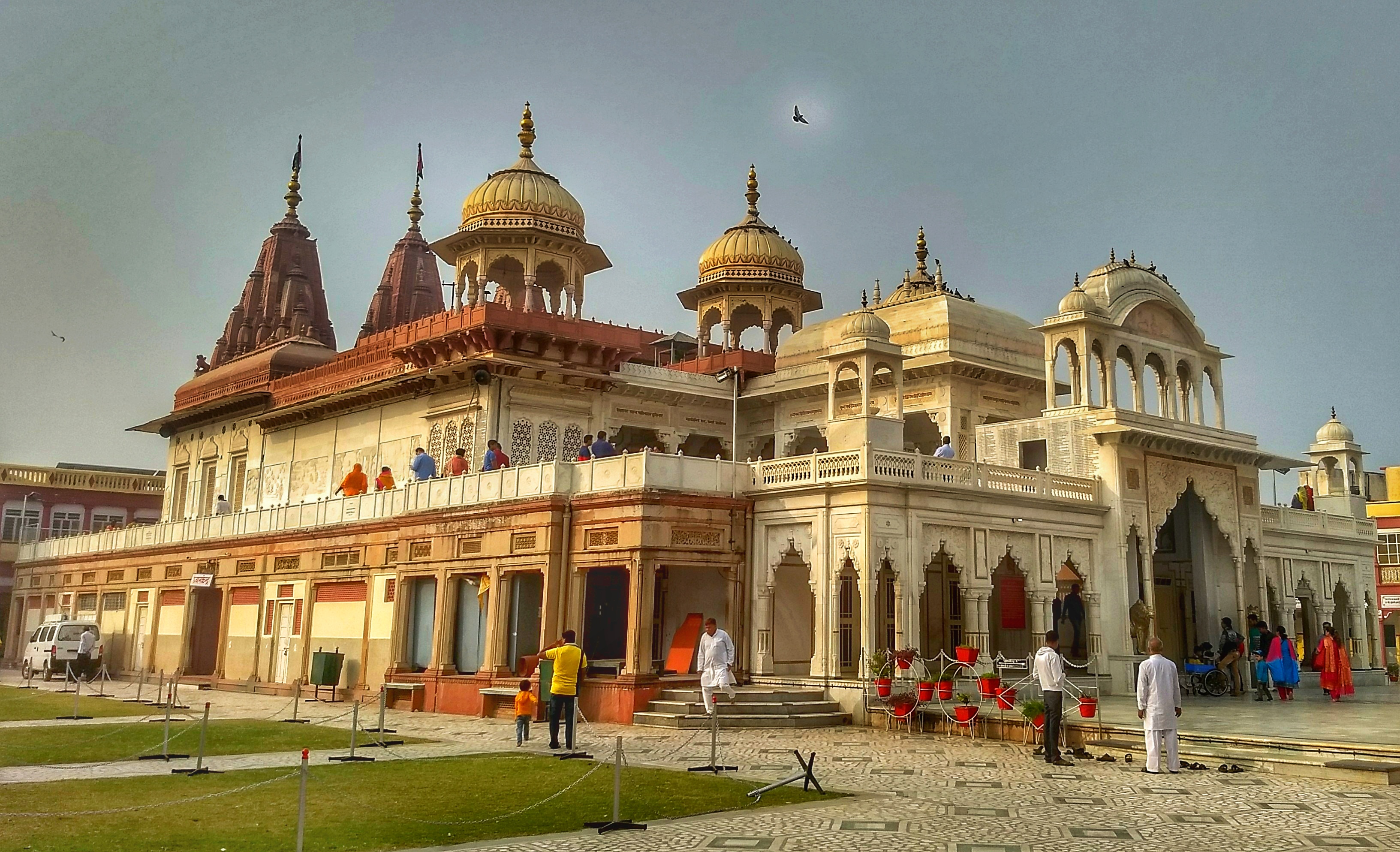 The small city of Karauli is world-renowned for its pale red sandstone that surrounds the entire city with a strong and sturdy wall and is also home to well-decorated Havelis, peaceful shrines, picturesque views and imprinted chhatris.
The small city of Karauli is world-renowned for its pale red sandstone that surrounds the entire city with a strong and sturdy wall and is also home to well-decorated Havelis, peaceful shrines, picturesque views and imprinted chhatris.
46. Tonk
This cross-cultural town is a mixture of Rajput buildings and Muslim architecture and is renowned for its old Havelis and mosques.
47. Hanumangarh
The city is best known for its temples and its historical significance as it was once a part of the Indus Valley Civilization. The main tourist attraction of Hanumangarh is the Bhatner fort.
48. Barmer
It is the fifth-largest district in India and is rich in the craft that includes wood carving, pottery, embroidery work and ajrak prints.
This district has a large variation in temperature, ranging from up to 51 °C in summer and to 0 °C in winter.
49. Sri Ganganagar
It is often referred to as “the food basket of Rajasthan” due to its fertile plains and is famous for its production of wheat, mustard, cotton, bajra, sugarcane and grams and kinnow, a hybrid citrus fruit.
50. Dausa
A small town named after a Sanskrit word Dhau-sa meaning Beautiful like Heaven is of historical and archaeological importance.
The major attraction includes Chand Baori (stepwell), Mehendipur Balaji, a Temple of Bajrang Bali (Lord Hanuman) and many others.
Famous National Park and Wild Life Sanctuaries in Rajasthan:
1. Ranthambore National Park
 The park is one of the worlds best-known wilderness areas. It gets its name from the Ranthambore Fort situated within its boundaries.
The park is one of the worlds best-known wilderness areas. It gets its name from the Ranthambore Fort situated within its boundaries.
It is home to the elusive tiger and also to an incredible variety of flora and fauna.
Apart from the tiger, you can also spot fox, hyena, sloth bear, leopard, caracal, jackal, mongoose, the elusive Indian wolf, the chital, sambhar deer, the blue bull antelope or nilgai, rhesus macaque, langur and variety of birds.
2. Keoladeo National Park
Formerly known as Bharatpur Bird Sanctuary, is one of the world’s most important bird feeding and breeding grounds. The park is home to different species of birds and animals.
3. Sariska Tiger Reserve
The first tiger reserve in the world to have successfully relocated the tigers. Situated in Alwar, It is nestled in the lap of Aravalli hills and contains mountains, grasslands, dry deciduous forests.
Apart from tigers, animals like jungle cats, rhesus macaque, sambhar, chital, wild boar, etc., are found here. A number of bird species, such as sand grouse, harbour quails, crested serpent eagles, etc. can also be spotted.
4. Kumbalgarh Wildlife Sanctuary
The park encircles the massive Kumbalgarh fort, is home to many endangered species. You can catch a glimpse of jungle cats, hyenas, jackals, leopards, sloth bears, nilgai, sambhar, chausingha, chinkara, hares, wolves, etc.
Apart from the animals, you can also gaze at a number of birds at the sanctuary. A variety of flora that includes a number of trees and plants that exhibit herbal properties is also a major attraction of this park.
5. Desert National Park
Located in Jaiselmer, the park displays various species of animals such as blackbuck, chinkara and desert fox. The highly endangered Great Indian Bustard can also be seen here.
In winter, the park hosts Eastern Imperial Eagle, Himalayan and Eurasian Griffon Vultures, and the Saker Falcon.
6. Udaipur Biological Park
 Also known as the Sajjangarh Biological Park is located just beneath the Monsoon Palace and was built with an aim to conserve the threatened flora and fauna within the area.
Also known as the Sajjangarh Biological Park is located just beneath the Monsoon Palace and was built with an aim to conserve the threatened flora and fauna within the area.
It is home to a number of varieties of animals and birds, which includes the Himalayan black bear, panthers, Indian porcupine, chital, ghariyal, marsh crocodile, white tiger, Asiatic lion, etc.
7. Nahargarh Biological Park
Located about 12 km from Jaipur, the park is famous for its vast flora and fauna. The most popular white-naped tit can only be found here.
The park is famous among bird watchers and makes for a great spot to catch different varieties of birds.
The Nahargarh Zoological Park houses animals such as Asiatic lions, panthers, hyenas, Bengal tigers, wolves, deer, crocodiles, sloth bear, Himalayan black bear, wild boar, etc.
8. Jhalana Safari Park
This safari park in Jaipur is popular for its leopard sightings. The park is immensely rich in flora and fauna.
You can spot striped hyenas, desert fox, golden jackal, chital, Indian palm civets, blue bulls, jungle cat, and many more.
Besides this, it is home to various species of birds, including the Indian Pitta, Dusky Eagle, Owl, Spotted Owlet, Indian roller, sikara, and hawks, among others.
Rajasthan Is Famous For:
Rajasthan has incredible and fascinating wildlife.
The bazaars are famous for traditional art, colourful crafts, fabrics, miniature paintings, blue pottery, carpets, antiques, homewares, spices, amazing jewellery and gems, embroidered textiles and many more.
The festivals in Rajasthan are colourful and rich in religion and traditions.
The great Thar Desert is also one of the famous parts about Rajasthan. The mighty forts are an architectural legacy of India.
Festival and Fairs in Rajasthan:
1. Bikaner Camel Festival
Bikaner Camel Festival, an annual festival dedicated to the ship of the desert and organised by Rajasthan Tourism in the month of January.
The celebrations include camel races, camel milking, best breed competition, fur cutting design, camel acrobatics and camel beauty pageants.
The camels are beautifully bedecked and form a colourful spectacle against the red backdrop of the Junagarh Fort.
Eating, souvenir-shopping and photography are famous at this festival. It also has skirt-swirling folk dancers, fire dancers and the spectacular fireworks show, that lights up the night sky above the fortified Desert City.
2. Kite Festival
It is held on 14th January every year and the Department of Tourism organizes this festival where tourists can enjoy kite flying along with various cultural performances.
3. Pushkar Fair
One of the world’s largest camel fairs, The Pushkar Fair (Pushkar Camel Fair) or Pushkar Mela, is an annual weeklong camel and livestock fair held in the town of Pushkar between the months of October and November.
Competitions such as the ‘longest moustache’, Matka Phod’ and ‘bridal competition’ attracts thousands of tourists.
4. Desert Festival
The festival is organised by the Department of Tourism around January-February every year.
It is a three days festival that lets you enjoy the rich and colourful Rajasthani folk culture.
Men and women dressed in their best and brightest costumes dance and sing ballads of bravery, romance and tragedy, while traditional musicians attempt to outdo each other to showcase their musical superiority.
The main attractions of the festival are puppeteers, acrobats, camel tattoo shows, camel races, camel polo, traditional processions, camel mounted bands, folk dances, etc.
5. Marwar Festival
The most popular festival in Jodhpur is a two-day festival, held every year in the month of Ashwin (between September and October) in memory of the heroes of Rajasthan.
The main attractions of this festival are the folk dance and music. Other attractions at the festival are the Camel Tattoo Show and various competitions like Moustache, Turban Tying, Tug of War, Matka Race, Traditional Dress Competition and many more.
6. Summer Festival
Mount Abu hosts a unique two-day summer festival. The festival has soulful ballad singing, mesmerizing folk dance styles of Gair, Ghoomar and Daph and also Sham-e-Qawwali, which features some of the best folk singers from various parts of India.
The festival also hosts horse racing events, tug of war, CRPF band show, skating races, and boat races on the Nakki Lake.
7. Teej Festival
Teej is a festival observed particularly in the western and northern states of India.
Women celebrate this festival by dancing, singing, getting together with friends, narrating stories, applying henna on hands and feet, wearing brightly coloured saris, playing under trees on swings on Haryali Teej and sharing festive foods.
The festival is dedicated to Goddess Parvati, also known as Teej Mata. On this occasion, a royal procession of Goddess Teej starts from the City Palace, winding its way through Tripolia Bazaar and Chhoti Chaupar on both days.
8. Gangaur Festival
It is one of the most important festivals in Rajasthan and is celebrated all over Rajasthan. Gangaur celebrates the union of Lord Shiva and Goddess Parvati and is a symbol of conjugal & marital happiness.
It is celebrated in the month of Chaitra (March-April), the first month of the Hindu calendar. Women worship clay idols of “Gan” & “Gauri” in their houses.
Unmarried girls seek the blessings of Gan & Gauri for a good husband, while the married women pray for the good health and long life of their husbands.
9. Nagaur Fair
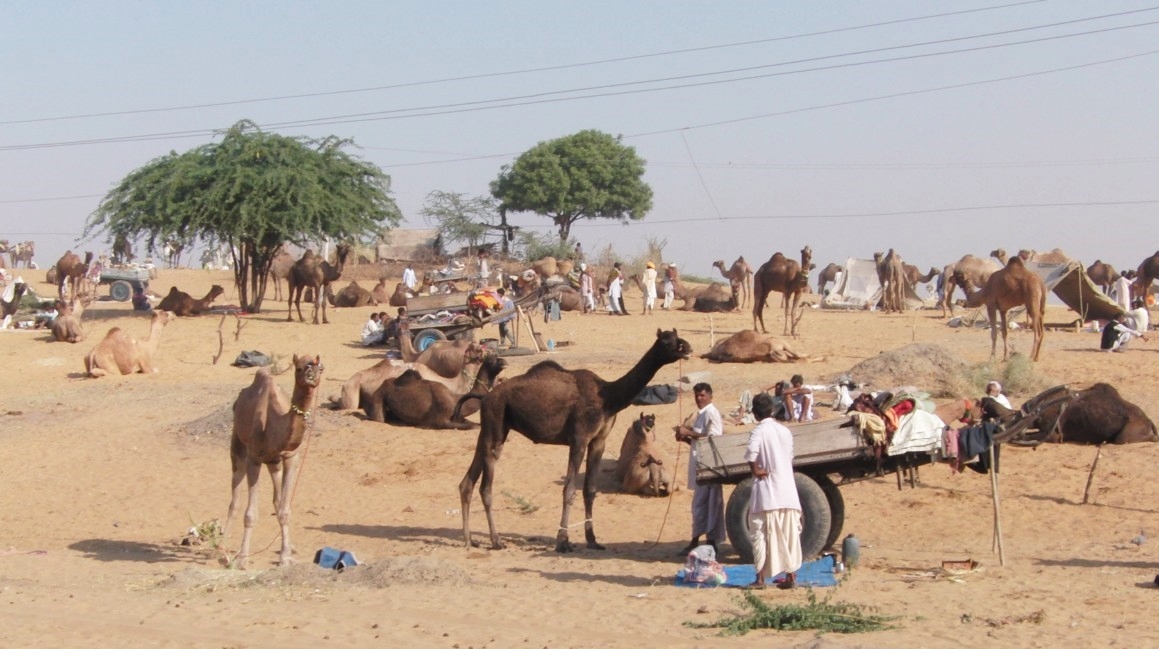 It is the second biggest fair in India, held every year between the months of January and February. Popularly known as the Cattle Fair of Nagaur, here owners gather to trade animals.
It is the second biggest fair in India, held every year between the months of January and February. Popularly known as the Cattle Fair of Nagaur, here owners gather to trade animals.
Bullocks, camels and horses are traded every year at this fair. The animals are decorated and even their owners dress up with colourful turbans and long moustaches.
10. Winter Festival
The annual Winter Festival is held in Mount Abu in December. It is a two-day extravaganza that brings together craftsmen and performers from every corner of the state.
It is also known for its events, such as kite flying, rowing competitions and poetry reading sessions, cricket, etc. A Grand procession marks the beginning of the festival.
‘Deepdaan’ ceremony held in the evening, where hundreds of diyas are set afloat in the water at the Nakki Lake as a form of respect.
11. Ranakpur Festival
Organized by the Department of Tourism, celebrates the culture and heritage of Rajasthan.
Fun activities like yoga, nature walks at the foothills in forests of Aravalli, visits to the Ranakpur Jain temple, hot air ballooning, tug of war, beautiful decorations, cultural programmes, the open-air amphitheatre at Sun Temple showcases attractive folk and classical performances every evening and much more.
This festival is mostly held on the 21st and 22nd of December every year.
12. Mewar Festival
The festival is observed to welcome the arrival of spring. Visiting Udaipur during the Mewar festival is highly recommended.
Local markets and shops are decorated with bright lights and decorations.
The festival is especially meant for women and presents them with an opportunity to dress in their finest and join the celebrations. Dancing, songs, cultural events and a firework display are highlights of the festival.
Plan Your Tour With Us
Let us help you get the best out of your holidays and a hassle-free trip.
Tell us more about your travel plans and we certainly offer you something of your choice & budget.
Blog | About Us | Shop | Trip Planner

